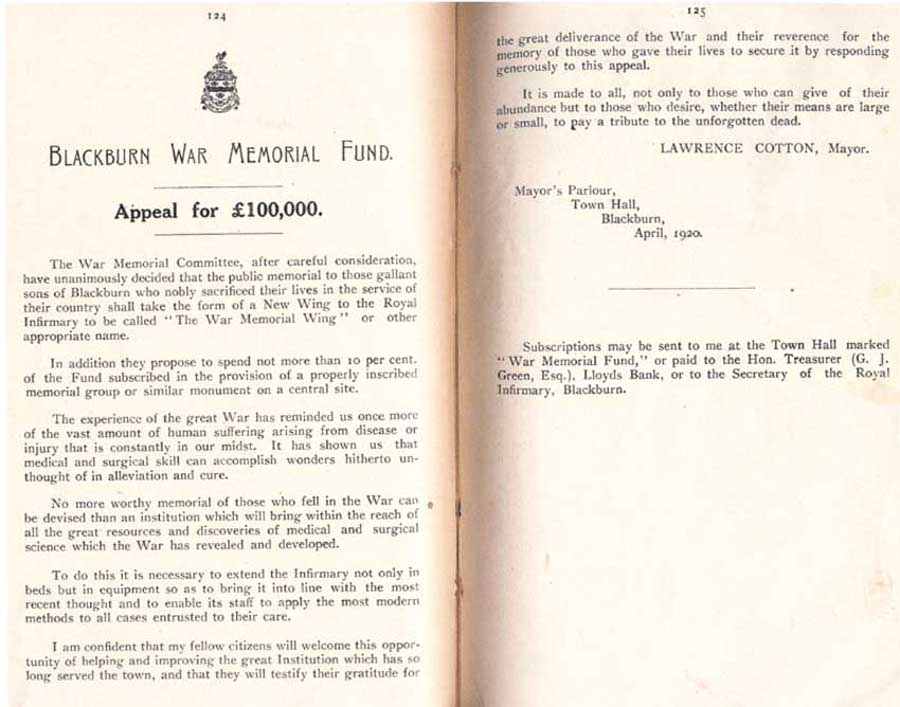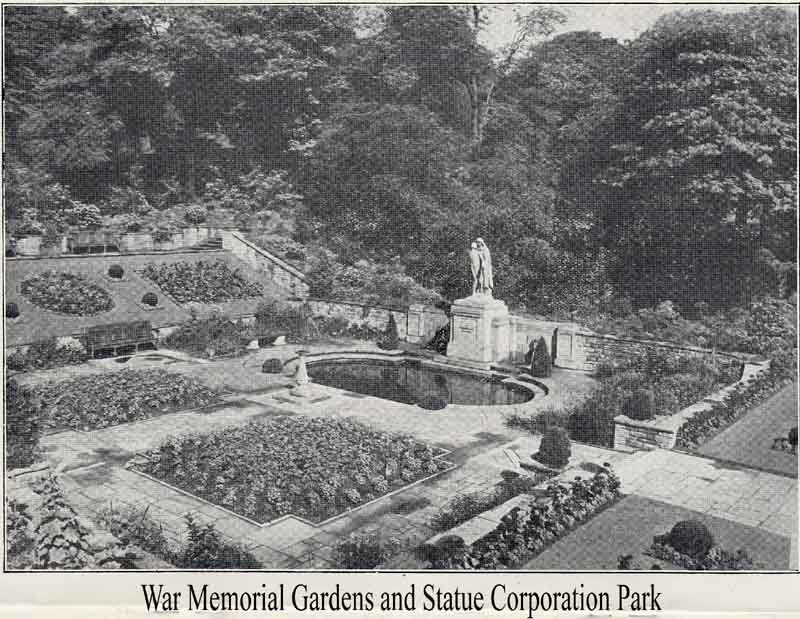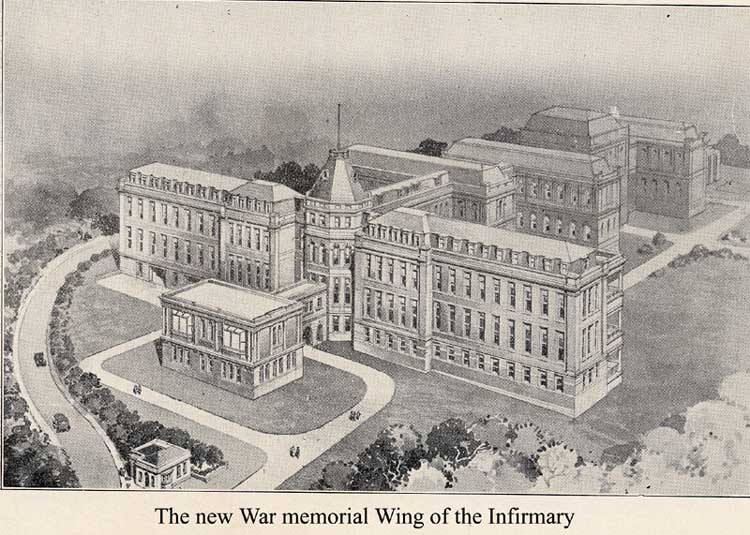War Memorial Wing
by Stephen Smith
There had been some sort of parochial dispensary for the treatment of the poor and sick of Blackburn since before 1794. In September of that year an advertisement was put in the Blackburn Mail for the “appointment of a doctor for the dispensary at Blackburn,” and in May of 1813 the same paper had an advertisement for a “Surgeon, Apothecary and Man-Midwife.” At a meeting held in the town in 1823 it was decided that a public dispensary should be started to treat not just the paupers of the town but those impoverished but not paupers, in time of sickness.
The new institution would be known as the Blackburn General Dispensary, it opened in premises at 58 King Street on February 1st 1824. Dr. Makland was appointed Physician, James Bailey and John Court were Superintendent Surgeons the Surgeon-Apothecary to the Dispensary was John Scaife; his salary was £120 per year with his accommodation being part of the building. In its first year 1513 patients were treated by the end of 1831 this had risen to over 4500. The Governors of the Dispensary, however, had bigger ideas, they wanted to build an Infirmary, which would cater for the whole Hundred of Blackburn, it was estimated that this could be achieved at a cost of £4000.
A fund was started, and by 1825, it had reached £650 with promises of a further £2,150. A year later, due to the depression in the cotton trade and food shortages, Blackburn and other surrounding towns saw riots and loom breaking which cost the area more than £11000. It was not a good time for an Infirmary fund, and the idea fizzled out, further attempts to revive the fund in 1829 came to nothing. The Infirmary did have a permanent fund, which at that time stood at £1250 and £1800 by 1834. The Dispensary itself began to run into debt in 1833, by the end of 1834 it was £145 in the red, by 1838 that debt had increased to £222.
A Committee was set up to look into its affairs, it was found that subscriptions were drying up, that in three years the permanent fund had fallen by £300, and perhaps worst the payment made by Blackburn was to be withdrawn from the beginning of 1838 this was mainly due to changes in the Poor Law. Because of these circumstances in June 1838 the Governors decided to close the Dispensary for good, with the closure went the scheme for an Infirmary. The permanent fund, which stood at £1500, was invested and by 1858 had doubled to £3000; this sum was to be handed to the new Infirmary fund.
The dispensary at 56 King Street opened February 1824
The idea for an Infirmary fund was taken up again in 1856 at the instigation of William Pilkington. At his election as Mayor he started the fund with a donation of £2000 with a promise of an annual endowment of £100. A public meeting was held in the town and further donations were promised. The eight-acres site chosen for the new Infirmary was on the Hollen Bank estate it was purchased from Joseph Feilden for £3200 of which he gave back £1600. William Pillkington, now in his second year as Mayor, laid the foundation stone on Whit-Monday the 24th of May 1858. The Infirmary, after a long delay caused by the depression in the cotton industry due to the American Civil War, was finally opened in 1864. In 1864-65 the Infirmary had 32 beds and dealt with 516 admissions and out patients. By 1876, 70 beds were available which increased to 90 by 1891. A total of 1,768 inpatients were treated with 6,121 outpatients being catered for. In 1893 a Nurses Home was erected in the grounds. The Infirmary was further extended in 1897 when the “Victoria Wing” was built to commemorate the diamond jubilee of the Queen. The Mayor, Fred Baynes, laid the foundation stone for this building. This new wing contained, among other things, an Operating Theatre and Sterilising Room, Anaesthetic Room, Recovery Room, and a new ward on the first floor. Further extensions were made in 1908, which included space for 14 more beds, the total number of beds had now reached 130.
On the 21st of April 1914 by a decree of King George V, the word “Royal” was officially added to the title, it was, in future to be known as “ The Blackburn and East Lancashire Royal Infirmary.”
1920 saw a record number of 2439 inpatients cared for and 6,083 outpatients were dealt with, however, with just 150 beds, only the seriously ill and patients requiring operations could be admitted on to the wards.
At this time and until 1946 when hospitals came under the umbrella of the National Health Service the upkeep of the Infirmary was by voluntary contribution, money for any new equipment, repairs or expansion, to the Infirmary, had always come from the general public, shop keepers and industry, and other fund raising activities, strange as it may seem now it was a very successful method of paying for things and the preferred way by The Board of Management.
For many years the workers of East Lancashire had voluntarily given to the Infirmary, but not in any organised way. On July 9th 1918 the Mayor of Blackburn Lawrence Cotton, called a public meeting of workers and Unions to discuss the financial position of the Infirmary. As a result of this meeting an scheme was started called “The East Lancashire Workpeople’s Hospital fund,” it was agreed that a deduction of 1d per week would be taken from workers wages this became known as the “Penny-a-week fund.” At its height this scheme alone raised £32,000 per year for the Infirmary and ran for almost 30 years.
The Infirmary before alterations
On the 3rd of February 1919 James Kay, Chairman of the Board of Management wrote “ Extensions and improvements are now needed [to the Infirmary] with a urgency intensified by the war beyond any previous experience in the history of the institution…It is now known that the war is leaving a legacy of thousands of soldiers suffering from maimed limbs and muscles and other grave complaints requiring treatment that can only be given in a fully equipped modern hospital. In short, Blackburn and East Lancashire requires an Institution of double the size of the present one, which has to meet the needs of a population of over 250,000.” He then goes on to give a list of requirements:
“Additional ward pavilions,
New eye, ear, nose and throat department, with complete operating unit,
Modern X-Ray, electrical and hydro-therapeutic dept.,
Department for massage and remedial treatment,
Dental department,
Pathological and Bacteriological department,
Department for genito-urinary diseases,
Modern kitchen (to replace kitchen erected 60 years ago),
Enlargement of nurses’ home to provide additional bedrooms, Dining rooms, etc., for nursing Staff,
Additional bedrooms, etc., for domestic staff,
Enlargement of Laundry.”
James Kay went on to say “Without presumption the Board venture to indicate a plan of valuable service to the community in carrying out this scheme of reconstruction and the much needed extensions in the hope that amongst the wealthy classes many may be found willing to assist in the development of such a work…” He finishes by saying, “ A most suitable manner of perpetuating the memory of those who have fallen in defence of the country is to make provision for the living who suffer, and a Hospital War Memorial is not only a tribute to the dead but a necessity to the living.”
This was echoed by the local newspapers, The Blackburn Weekly Telegraph of February 21st 1920 had this to say, “When the time come for Blackburn to decide what form its war memorial shall take it is to be hoped that the claim of the Royal Infirmary, so insistently put forward at the annual meeting of the Governors…will receive due consideration.”
Blackburn Council’s General Purposes Committee appointed a War Memorial Committee whose remit was to choose an appropriate Memorial for Blackburn dedicated to those men and women who had lost their lives in World War One. At a meeting held on the 8th of March 1920, and presided over by the Mayor Lawrence Cotton, the Committee decided that any Memorial should, “be one which would give the greatest satisfaction to the greatest number.” The Mayor told the meeting that he had been approached by members of the Hospital Board of Management asking him to start a fund to raise £100000 for the much needed hospital extension. It was, therefore decided the best way ahead would be to combine the War Memorial and Infirmary extension and he therefore recommend that “the towns memorial should take the form of an extension to the Royal Infirmary, with something permanent and distinctive say a monument erected on a central site like the boulevard, which would be a constant reminder of the men who had fallen in the War.” It was decided that a general appeal for funds would be issued to the people of East Lancs. James Kay was delighted at the result and said “The [Hospital] Board record with gratitude the unanimous decision of the Blackburn War memorial Committee, that the erection of a New Wing at the Royal Infirmary should form the principle memorial to those gallant sons of Blackburn who nobly sacrificed their lives in the service of their country.” In April 1920 Lawrence Cotton, the Mayor put out an appeal to the people of East Lancashire. The full appeal is shown below.

Appeal for £100000 for the War Memorial Wing put out by the Mayor Lawrence Cotton in April 1920By the end of the year £42000 had been received or promised, some of this had come from the employers of the cotton mills around East Lancashire, they had agreed among them selves that a contribution 5s per every loom would be made, some gave as much as10s per loom.
The Infirmary Board selected Colonel Dr. D.J. Mackintosh, who was an expert in hospital construction, to design the building and they appointed Messrs Sames and Green of Richmond Terrace Blackburn as the architects; the building contract was given to James Whittaker and Sons of Blackburn. At the annual general meeting of the Board of Governors in 1923 the plans for the wing were inspected and it was decided that building work on the extension should commence as soon as possible. The full scheme had to be carried out over several years, with work being done as funds permitted.
On Saturday the 24th of May 1924 the ceremony of laying the foundation stone took place. There was a civic procession which started from the King Georges Hall at 2.45 p.m. The procession went from Northgate to Sudell Cross, then to King William Street, Darwen Street, Bolton Road and on to the Infirmary. The 201st battery 51st Brigade Royal Field Artillery (T.A.) lead the way followed by the 4/5th Battalion East Lancashire Regiment, the National Reserves and the Blackburn branch of the British Legion with other ex-service men. Various youth organisations, came next with members of the War memorial Committee, then came the dignitaries from the Urban District Councils of Rishton, Great Harwood, Church, Oswaldtwistle, Clayton-le-Moors and Blackburn, the Mayors of Blackburn, Accrington, Darwen, Clitheroe, and the borough Members of Parliament followed. The weather had not been good, and there had been sporadic showers all the morning as the ceremony began at the Infirmary the heavens opened and as the Blackburn Times put it, “Little could be seen but umbrellas.”
The Mayor of Blackburn J.T.T. Ramsay opened the proceeding with a speech which began “ Fellow townsmen, I am deeply honoured in having to address you on this history making occasion, and express my gratitude to the Memorial Committee for the opportunity of doing honour in your name to our illustrious dead, who took a total adieu of the world not caring for a monument, history of epitaph, nor so much as the bare memory of their name to be found anywhere but in the universal register of God…” After this the National Anthem was played and prayers were said. James Kay then presented a silver trowel to Mrs Elma Yerburgh who then laid the Foundation Stone with these words “In the faith of Jesus Christ we place this Foundation Stone, In the name of the Father, and of the Son, and of the Holy Ghost. Amen.”
The inscription on the stone read,
“County Borough of Blackburn.
War memorial Wing.
This Stone was laid By Mrs. R.A. Yerbough, 24th May, 1924.”
The ceremony concluded with the Hymn “ O God, our help in ages past,” played by the Salvation Army band. The celebration then broke up.
By the end of 1924 the estimated cost of the new wing inclusive of furnishing and equipment was put at £90000, of this £50000 had been received or promised, however, money was not coming in as fast as first anticipated, due mainly to a fall off in trade in the region. The Infirmary Management Board promised that, “as soon as trade conditions permit, the War Memorial Committee will issue [another] public appeal for the balance of £40000.” This appeal was put out by the Mayor James Stanworth in August 1926. No specific sum was asked for but it was “made to all, not only to those who can give of their abundance, but to those who desire, whether their means are large or small, to pay tribute to the unforgotten dead.”
While work on the Infirmary War Memorial Wing was getting under way another scheme, which had close links with it was being finished, that was the War Memorial situated in Corporation Park. The War Memorial Committee had set aside £10000 for such a project, this money paid for the gardens and statue. The unveiling of the statue took place on Saturday 2nd of August 1924. The gardens had been beautifully laid out for the occasioning, the procession made its way from Northgate to the park. Five mothers who had lost a total of twenty members of their families did the unveiling of the bronze statue.

From the very beginning of the scheme it had been recognised that other Improvements would be needed (see above) in order to make the Infirmary suitable for the district of East Lancashire some of this work, it was decided would be carried out in conjunction with the building of the New Wing, contracts were put out for these extensions. It was suggested that these further extensions could be paid for by people who lived in the out lying districts of East Lancashire, while the people of Blackburn would concentrate on the Memorial wing. These projects were up and running by mid 1925 and the by 1926 the first part, consisting of a new laundry, boiler house and mortuary chapel at a cost of £19000 were completed. Work could now begin on the enlargement and reconstruction of the kitchens; this project was finished in 1928 and cost £6000. Work on the Memorial Wing was progressing well and by May 1928 almost finished. In that month the people of Blackburn had the opportunity of looking round the new wing, which they did, according to the newspapers, in there hundreds.
The opening ceremony took place on Saturday the 16th of June 1928 and was witnessed by a crowd of over 10000. Mrs Elma Yerburgh would be performing the ceremony but this time, in contrast to the laying of the foundation stone four years previously, it was to be done in glorious sunshine. The procession, which included ex Lieutenant Commander P.T. Dean and ex Company Quartermaster-sergeant W.H. Grimbaldeston both winners of the V.C in the Great War, left the King Georges Hall at 2.45 pm and followed the same route as in 1924 and as then, the streets were lined with hundreds of spectators waving union flags, the shops and houses were also bedecked with bunting and flags. Taking part in the ceremony were forty people who had been present at the laying of the foundation stone of the Infirmary in 1858.
After an opening speech by the Mayor J.A. Ormerod, the Bishop of Blackburn P.M. Herbert, who had been appointed the first Bishop of Blackburn the previous year, said prayers. The architect then presented Mrs Yerburgh with the key for the door which she unlocked the with these words “I hereby declare this War Memorial Wing of the Blackburn and East Lancashire Royal Infirmary to be now open.” After more prayers the Memorial Wing was handed over to the to the Infirmary Board of Management. The proceedings ended with a hymn composed by John Critchley Price that had been sung at the laying of the foundation stone of the Infirmary in 1858. That night, as part of the celebrations, bands performed in Corporation Park, Queens Park and Roe Lee Park.

The new War Memorial Wing was built on the North side of the Infirmary; it faces what used to be the main entrance and overlooks Bolton Road. It is four stories high. When it was built it provided 98 beds and cots in five large and five small wards. On the top floor there was accommodation, complete with bedrooms and bathrooms, for members of staff. In front of the wards is a two-storey building which contained two Operating Theatres, Sterilising and Anaesthetic rooms with staff accommodation; the ground floor contained a Board Room and Offices. Above the entrance to the wing are the Royal Coat of Arms with “Blackburn and East Lancashire Royal Infirmary.” carved in relief over the top. The main entrance hall has eight stained glass windows bearing the Coats of Arms of Blackburn, Darwen, Accrington, Clitheroe, Rishton, Great Harwood, Church, and Oswaldtwistle. The Blackburn Coat of Arms is on the floor of the main hall done in mosaic. On the wall of this hall is a bronze plaque with the inscription:
“Blackburn and East Lancashire Royal Infirmary.
WAR MEMORIAL WING
These buildings were erected as a memorial to the men from Blackburn
And East Lancashire who fell in the Great War 1914—1918
The foundation stone was laid by Mrs. R.A. Yerburgh on May 24th 1924
and the opening ceremony performed by her on June 16th, 1928.”
Although the War Memorial Wing was now open and as James Kay, the Chairman of the Board, said that, “…with these extensive additions the number of patients waiting for admission has been reduced to a minimum” there was still work to do to complete the whole scheme. Late 1928 saw the completion of the new X-ray and Physiotherapy department costing £20000. There were now just two outstanding projects; these were an extension to the Nurses’ Home and one to the Out-patients Department. It was thought that the Nurses’ home was the more important and so it was given priority. The estimated cost for this work was £25000, however things did not go exactly to plan, due to lack of money the extension to the Nurses’ home was not completed until 1934. Once again Blackburn was going through a depression in trade and work on the Outpatient was postponed.
In later years many alterations took place and the look of the Infirmary changed dramatically. However there was no more room for expansion and it was decided that the Infirmary would have to move from the site it had occupied for almost 150 years and a new super complex began to be built at Queens park on the site of the old workhouse. By July 2006 most of the services had moved to the new Hospital, which was to retain its “Royal” status and be known as “The Royal Blackburn Hospital” the building was officially opened on 8th July 2006.
The site of the Infirmary was sold to Barratt Homes, who got planning permission to build 253 homes on the site, at first it was thought that much of the old part of the Infirmary would be retained and turned into apartments but an Heritage Assessment deemed that the early buildings had been so much altered and built upon resulting in a loss of both external and internal detail that “they do not warrant retention in any future development scheme.” It was decided that The War Memorial wing would be the only portion that would be retained, “The War Memorial Wing,” they said, “appears to be the only building that retains much of its structural integrity, historic detailing and plan form, though limited evidence survives of historic fixtures and fittings.”
By incorporating the War Memorial Wing into the new housing scheme it is certain that the memory of those men and women of East Lancashire who have laid down their lives for their country will live on and hopefully never forgotten.

